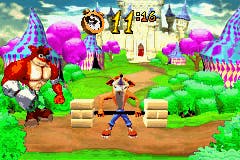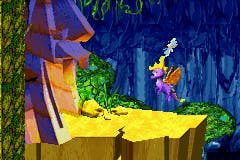Crash Bandicoot: Fusion vs Spyro: Fusion
Jak and Ratchet may never meet for all we know, but Naughty Dog and Insomniac's original heroes clearly get on that much better...
Crash and Spyro games have been cash cows on whatever platform they've been issued on. Their original creators Naughty Dog and Insomniac moved onto franchises new a long time ago now (so much so that both are now onto their third incarnations already), but the likes of Traveller's Tales and Vicarious Visions have kept the brands alive by giving the masses what they want. To the discerning platform kleptomaniac, though, they've drifted off and contracted sequelitis to an extent, and most of those who really want some serious platform kicks tend to mutter something along the lines of "they're for kids", and they're not far off the mark.
So why are we bothering to examine two obviously kid friendly games on a kid friendly gaming platform? The summer release drought has had a part to play, undoubtedly, but we were just genuinely curious to see how Vivendi-Universal has managed to 'fuse' these two huge-selling brands into two simultaneously released titles that require gamers to buy both to squeeze the most out of them. We suppose it was only a matter of time before other publishers took the lead of Nintendo's Pokemon franchise, but at least in this case VU Games bothered to make two relatively distinct games that actually are seemingly designed with two completely different audiences in mind.
Fusion Frenzy

Hard to predict, we know, but the premise of both Crash and Spyro Fusion is simple side scrolling action. We know you're probably reeling with the shock of that information, but bear with us. It does get better. The actual platforming is pretty minimal, and forms little more than an elaborate hub for the dozens of mini-games that punctuate the five play environments in each title. There are similarities between the two titles on this basis, but they also sport the added obsessives goal of collecting up to 167 trading cards that are, predictably, split between the two and require linking of the two to 'catch them all'. But while Crash Fusion is surprisingly good, full of a varied array of often quite challenging mini-games, Spyro Fusion immediately strikes you as not only unimaginative by comparison but nowhere near as varied, and actually gets very boring very quickly. It doesn't get much better either.
Crash Fusion works on two levels. Each of the five worlds is peppered with mini-games which you reach in typical 2D side scrolling fashion, but these play areas serve as little more then a glorified hub to reach the portals where the mini-games reside. From there on you're generally tasked with reaching the goal and collecting the crystal with a non-essential secondary task providing a bonus crystal which is up to you whether you complete or not. However various sections of each world are fenced off until you accumulate a predetermined number of crystals, so it's generally worth your while to complete both elements of each mini-game if you want to see everything.
The quality of the Crash Fusion mini-games is generally very good, with the likes of Polar Express recalling memories of Donkey Kong Country's Rhino charge; Bat Attack is a one of several side scrolling shooters; and the repeated use of Crate Step is typical of the fiendish and addictive quickfire games, which are perfect bite-sized chunks that work well on short journeys or if you're in need of a quick fix.
Party of Five

Each of the five environments in Crash's world sport nine mini-games of some description; some are full on challenges, while others are no more than micro interludes that require the manic bashing of the A button to put out a fire, for example. Not all of them are exactly works of art, of course, but they're excellent time fillers that serve the purpose of providing quick fix gaming that's exceptionally easy to dip into. That's also partly thanks to the added Party mode, which displays all the various mini-games you've unlocked in each area up to that point.
It won't take any experienced gamer very long to plough through what's on offer, but there's a certain charm that prevents you being too cynical and offhand about it. Think of it as a compendium of lots of 8-bit gaming experiences and it's possible to feel a pang of nostalgia for the simplicity of the way gaming used to be. As a result, it feels much more than just another contrived platform game, and Vicarious Visions can feel satisfied of a job done reasonably well. It just comes down to whether you think it's worth the cash. At full price, we'd almost always baulk at paying that sort of cash for tea break budget retro tinged gaming, but at the right price it's not bad at all.
How likely you're able to take advantage of the multiplayer games is another story. Each world has a trio of simple link-up games, (for two or up to four players) like the reprise of the first boss battle where your characters are lobbing objects at each other's platforms in order to send one another plunging to their doom. Simple, entertaining fun, but some require two cartridges, so that immediately limits the probability of your being ever able to see what they're like. Isn't this always the problem with GBA link-ups?
Defused

Spyro, meanwhile, involves a similar portal mechanic as Crash, with typically cutesy levels leading to five portals per world. In Spyro's case, however, there's no need to worry about secondary objectives, which tends to result in most mini-games being ultra simplistic. For some reason, they tend to involve fairly dull guide-and-shoot mini-games which even the most unskilled gamer would have difficulty not finishing on their first or second go. The boss battles can be a little trickier, but even these won't exactly prove much of an obstacle.
Both games look cute and colourful enough - well up to the standard of almost every other Vicarious Visions title you've ever seen, all replete with the trademark sound effects of the originals. Technically there's little to moan about. The gripes are really mainly relating to the individual games, which for anyone remotely experienced will quickly become far too familiar and untaxing to warrant extended interest.
Crash Fusion deserves far more than to even be associated with Spyro Fusion. There was no need to invisibly target both games at wildly differing audiences. To the end user, both are roughly similar games trying to achieve the same ends. The truth is they're poles apart and both get tarred with the same brush when releasing them as entirely separate games would have done the trick. Multiplayer gimmicks and link-up modes don't link what are two very different games that aren't helped by their close associations. Choose your cutesy 32-bit gaming heroes wisely...

